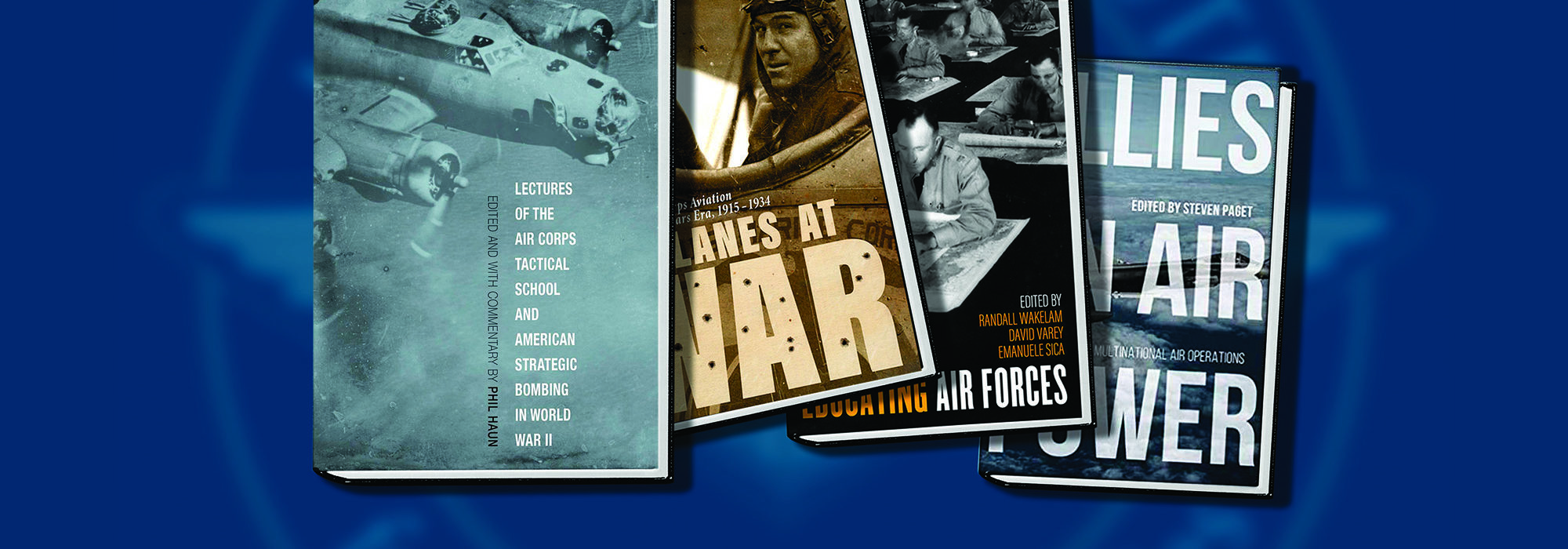AFA’s Mitchell Institute for Aerospace Studies has partnered with the University Press of Kentucky for an aviation and air power series of books that can serve as a go-to reference and resource for anyone interested in military aviation and air power history.
Series editor Brian Laslie—also the deputy command historian at North American Aerospace Defense Command and U.S. Northern Command, as well as an adjunct professor at the U.S. Air Force Academy and the Citadel—said he hopes the series will help “bridge the gap between the academics and the practitioners” and deliver these ideas and scholarship to a larger audience.
One of the first books published in the series is “Lectures of the Air Corps Tactical School and American Strategic Bombing in World War II.” Phil Haun, who edited the book, “went back into the archives” and put historic lectures and other documents together in a single volume, Laslie said.
Douglas Birkey, executive director of Mitchell, said the book represents the “intellectual baseline that has guided the Air Force” through its history.
“There is no Sun Tzu or Clausewitz or any equivalent single point for the Air Force,” Birkey explained, referencing the military strategists who wrote “The Art of War” and “On War,” respectively.
“These lectures, and this intellectual period,” are the “bedrock” or “main touchstone” for the Air Force, he said, noting that “prior to this book coming out, it was darn near impossible to get these things, because they were buried down in the archives at Maxwell” Air Force Base, Ala. “This really made it available. And you can’t do a complete historical assessment of, really, World War II or other key periods without looking at these things.”
The book also includes the air plan for World War II as an appendix, Laslie said: “Everything that we used in World War II … were the foundational documents for our strategy, Phil put into this book.”
Another title published in spring 2019 is “Biplanes at War, U.S. Marine Corps Aviation in the Small Wars Era, 1915-1934,” by Wray R. Johnson. Laslie said he wanted to make sure Air Force, Army, Navy, and Marine Corps aviation were represented in the series, and this book is “the development of Marine Corps aviation in the interwar period,” or “how did the Marine Corps decide what to do with the airplane.”
The Marine Corps was involved in several operations during that time period—in Haiti, in the Dominican Republic, in Nicaragua, and elsewhere, Laslie said—and they “developed this idea of supporting guys on the ground, guys who were in close contact with the irregular opponents, so I think what Wray does brilliantly in this book is, [show] the Marine Corps’ legacy of how they developed their own use of air power.”
“Educating Air Forces: Global Perspectives on Airpower Learning,” edited by Randall Wakelam, David Varey and Emanuele Sica, which was published in December, is an edited volume “chock full” of fantastic contributors, Laslie said.
“It’s a veritable who’s who of air power authors,” and focuses on how air forces teach their Airmen and educate their air forces, Laslie said. It includes chapters on the U.S., Germany, Australia, Canada, and the United Kingdom.
“Allies in Air Power: A History of Multinational Air Operations,” edited by Steven Paget, comprises chapters from a variety of writers—including Bert Frandsen, Benjamin Lambeth, and Richard Hallion—that examines how air power nations work together, Laslie said.
“If there is an international conflict, it’s highly doubtful that any one nation is going to be out there operating alone. And this has kind of become the model of operations. If you go back and look at Desert Storm, and the conflict in the Balkans, and on into, you know, Iraq part two and Afghanistan, I think most people would probably tend to think of those as American operations, but they’re not, right? … They’re combined operations. So, how do we all work together, or how do air forces of various nations work together?” Laslie said, adding, “The bottom line is, it’s instrumental that we work together.”
The next book in the series, “Fallen Tigers: The Fate of America’s Missing Airmen in China during World War II,” by Daniel Jackson, will be published in May. Laslie expects the book to be “really, really popular,” in part because of the aerial combat dogfighting, but also because Jackson has “done just next-level stuff” on the Flying Tigers in WWII.
The book includes “the harrowing stories of what these guys went through after they were shot down, attempting to evade capture, and it’s equally as much about the Chinese allies who helped our air crews out,” Laslie said.
Jackson is “such a colorful and engaging writer,” said Jackie Wilson, marketing manager for the University Press of Kentucky. “We’re really excited about this release.”
